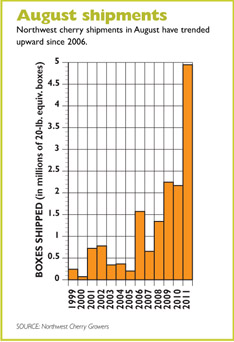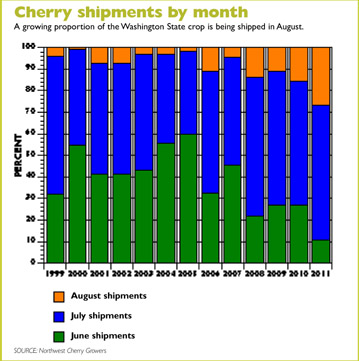Sweetheart, a late-season cultivar developed at the Summerland research center in British Columbia, Canada, is the second-most planted variety in Washington State.
Photo courtesy of Willow Drive Nursery
Last year’s record volume of Northwest cherries shipped in August and September was partly due to the year’s cool weather and lateness of crop. But a closer look shows a growing trend of late-season shipments.
Nearly 5 million boxes of Northwest cherries were shipped in August in 2011, representing almost 27 percent of last year’s total crop, said B.J. Thurlby during a report to the Washington State Fruit Commission. Thurlby is president of the Fruit Commission and Northwest Cherry Growers, the promotional arm for cherry growers in the five states of Washington, Oregon, Idaho, Utah, and Montana.
“Some say the lateness of 2011 was an anomaly because of the weather,” Thurlby said. “But if you look at shipping data trends from the last five years, you’ll see a major shift is occurring.” In 2007, August cherry shipments represented 4.5 percent of the Northwest crop, growing to 13.8 percent in 2008, 11 percent in 2009, and 15.5 percent in 2010. In the early 2000s and late 1990s, August shipments were generally less than 4 percent of the crop.
Late varieties planted
Later-maturing varieties in later districts now stretch the season into late August through Labor Day. The 2011 Washington tree fruit survey, conducted by the U.S. Department of Agriculture, showed more than 38,000 acres planted in the state, representing a 6 percent increase in cherry acreage from the previous survey five years earlier. The survey found that the late variety Sweetheart, with 6,500 acres, is the second most planted variety behind number-one Bing, and Skeena, another late variety, had 2,500 acres planted. Acreage of Chelan, an early variety, was reported at 2,500 acres.
The survey also showed that newer cherry plantings have higher tree densities. Average tree density for Sweetheart was 295 trees per acre compared with 167 per acre for Bing. Statewide, tree density increased 13 percent (235 trees per acre) compared with five years ago. Wenatchee, the latest district in the state, reported the highest tree density at 275 trees per acre compared to the Yakima district at 210.
Increasing acreage of late varieties and higher densities of recent plantings all point to a growing proportion of late-season cherries from the total crop.
 August reality
August reality
Thurlby believes that shipping an average of 3.5 to 4 million boxes in August will be the new reality. “August is now a huge piece of our business moving forward,” he said.
Moving a significant portion of the crop in August comes with opportunity and challenge in redefining a cherry season that now may last 16 weeks or more.
Historic retailer perceptions will need changing, Thurlby said, noting that retailers often switch from July cherry promotions to other fruit in August. “For years, we’ve been a specialty item. Now, we will have to have cherry promotions during the whole month of August to get the crop sold.”
The industry also needs to help retailers overcome “cherry fatigue,” a term he often hears mentioned during his visits with retailers in August. “Cherry fatigue is a retailer mindset that we must overcome. It has nothing to do with the quality of our cherries in August, which are great, but deals with retailers who want to move to other fruit.”
He notes there is great opportunity to drive cherry sales in August and capitalize on the core cherry consumer, but it will take education, outreach, and fresh thinking. “Fifty-five percent of cherry sales are impulse buys and categorized as incremental sales. That means we’re not taking sales away from other items but are adding to the shopping cart.”
Northwest Cherry Growers is sharing this year with retailers a late-season cherry report recently compiled by the Nielsen Perishables Group. The report identifies drivers of success in late-season cherries and provides strategies and recommendations to help retailers boost cherry revenue. “The retailers that are successful are the ones that continue to promote cherries late into the season,” said Thurlby. “We’ve known this, but now we have documentation from a third party to prove it.”
The Perishables Group found that in peak season, cherries made up 14 percent of the dollar share of total fruit sales nationally. However, sales were still strong during the five-week late-season period last year (July 31-September 3), when they found cherries accounted for 8 percent of the dollar share of fruit sales.
Retailers welcomed cherry sales last August, said Suzanne Wolter, marketing director at Rainier Fruit Company, Selah, Washington. “Most were telling us that it was their best cherry year ever,” she said. “Retailers embraced the longer season, because they needed the sales in August that they didn’t have in July.”
As long as fruit quality stays high at the end of the season and the consumer continues to have a good eating experience, cherries can be successful in August, Wolter said. “Quality at the end of the season has to be as good as the front end.”
Mac Riggan, vice president of marketing at Chelan Fresh, the marketing arm of Chelan Fruit Cooperative in Chelan, Washington, echoed Wolter’s sentiment on quality.
“The eating quality of cherries is even more important in August,” said Riggan. “By the time we get to August, the consumer has had cherries for three months and that pent-up demand is gone. Good eating quality—size, flavor, freshness—becomes even more important at the end of the season. Cherries are fighting for shelf space with other fruits, but cherries can give retailers some of the highest returns if fruit are good quality.”
Riggan believes that August cherry shipments and a trickle of shipments into September will represent about 20 percent of the total crop. Late-season exports also have opportunity for expansion, helping move the crop.
“The key to a good back end is a good start,” he said, adding that orderly marketing of a quality crop is what’s needed, though that is often out of industry’s control.
He believes growers do the best job possible of producing a quality cherry, from aggressive pruning to managing fruit-to-leaf ratio. “Washington cherry growers are very proactive, hard working, and generally understand what’s needed to produce quality fruit. Growers have learned to balance and manage crop load while achieving maximum quality.”
Labor implications
Besides retail issues, a later cherry season has labor implications. As the Northwest cherry industry extends its market window through the end of August, more cherry pickers will be needed than in the past when the season finished in late July.
Holding on to cherry workers longer will be important, but it also might be easier, as Stemilt Growers’ Roger Pepperl pointed out. “Many of the late varieties are planted in modern orchards with dwarfing rootstocks and higher densities, and are more attractive to workers.”
The need for workers later in the season could be a blessing in disguise, said Mac Riggan of Chelan Fruit Marketing. With more cherry work available, workers may be interested in coming to the Northwest earlier and be able to work until apple harvest starts. “It may help us secure workers for apple harvest,” he said.
For growers with late cherries and early apple varieties like Gala, the combination may give workers longer employment.

Leave A Comment